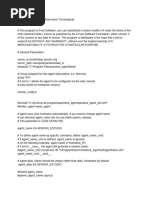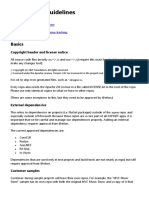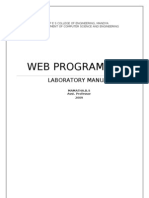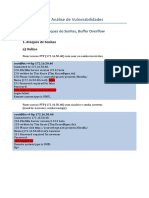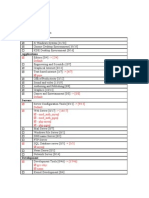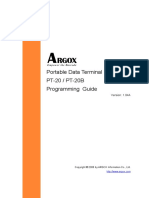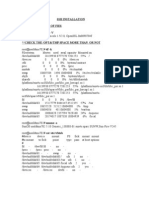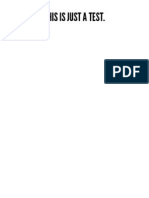0 ratings0% found this document useful (0 votes)
81 viewsSPSD
SPSD
Uploaded by
openid_E6TiHptKThis document provides information about SharePoint Solution Deployer (SPSD) version 5.0.3.6439, an open source tool for deploying and retracting SharePoint solutions. It describes how SPSD is configured using XML environment files, how to create custom environments, and how to use extensions and logging in SPSD.
Copyright:
© All Rights Reserved
Available Formats
Download as TXT, PDF, TXT or read online from Scribd
SPSD
SPSD
Uploaded by
openid_E6TiHptK0 ratings0% found this document useful (0 votes)
81 views3 pagesThis document provides information about SharePoint Solution Deployer (SPSD) version 5.0.3.6439, an open source tool for deploying and retracting SharePoint solutions. It describes how SPSD is configured using XML environment files, how to create custom environments, and how to use extensions and logging in SPSD.
Original Description:
SharePint Deploy
Copyright
© © All Rights Reserved
Available Formats
TXT, PDF, TXT or read online from Scribd
Share this document
Did you find this document useful?
Is this content inappropriate?
This document provides information about SharePoint Solution Deployer (SPSD) version 5.0.3.6439, an open source tool for deploying and retracting SharePoint solutions. It describes how SPSD is configured using XML environment files, how to create custom environments, and how to use extensions and logging in SPSD.
Copyright:
© All Rights Reserved
Available Formats
Download as TXT, PDF, TXT or read online from Scribd
Download as txt, pdf, or txt
0 ratings0% found this document useful (0 votes)
81 views3 pagesSPSD
SPSD
Uploaded by
openid_E6TiHptKThis document provides information about SharePoint Solution Deployer (SPSD) version 5.0.3.6439, an open source tool for deploying and retracting SharePoint solutions. It describes how SPSD is configured using XML environment files, how to create custom environments, and how to use extensions and logging in SPSD.
Copyright:
© All Rights Reserved
Available Formats
Download as TXT, PDF, TXT or read online from Scribd
Download as txt, pdf, or txt
You are on page 1of 3
###############################################################################
# SharePoint Solution Deployer (SPSD)
# Version
: 5.0.3.6439
# Url
: http://spsd.codeplex.com
# Creator
: Matthias Einig, http://twitter.com/mattein
# License
: MS-PL
# File
: Readme.txt
###############################################################################
Warning: Leave all script files starting with SPSD_ in the Scripts folder untouc
hed in order to be able to easily update to the next version of the scripts.
### Environment files
SPSD is configured with environment xml files located in the /Environments folde
r
How to create environments:
1.Modify the 'default.xml' environment definition XML in the "Environments" fold
er
2.Create your own environment file in the "Environments" folder
- If you name the file after a machine it will be used when the script runs on
that machine,
- If you name it after a username, it will be used when the script runs by thi
s user,
- If none of the above exist, default.xml is used
3.Extract any XML node of a environment file to a separate file and specify the
ID and FilePath tags.
SPSD will automatically merge the files together.
This allows you to reuse parts of the configuration for different deployment e
nvironments.
The referenced file should be place in the environments folder.
4.Specify variables in the environment definition file, which will be replaced o
n runtime
You can also use system environment variables (run "Get-ChildItem env:" in Pow
erShell to see all available variables)
### Environment Editor
To edit the xml files you can use the SPSD Environment Editor located which can
be downloaded from http://spsd.codeplex.com/releases/view/100340.
Comments in the XML files will be lost when saving with the Environment Editor.
Currently the environment editor does not yet support
Configuration
- Compatibility level
- Require Languages
Extensions
### Scripts/AppLogo.txt
If you want to embed your own ascii art logo or application info, please customi
ze the file Scripts/AppLogo.txt.
Links:
- http://patorjk.com/software/taag/#p=display&h=0&v=0&f=Doh&t=SPSD
- http://picascii.com/
### Scripts/CustomTargets.ps1
The custom targets PS file can be used to perform custom actions at cert
ain events during the deployment process
The available Events are (in order how they are called):
- RunCustomPrerequisites
CheckCustomPreconditions
Initialize
BeforeDeploy/BeforeRetract/BeforeUpdate
AfterDeploy/AfterRetract/AfterUpdate
SkipSolution
Finalize
### Scripts/Extensions and Environments/Extensions
SPSD has an extension szstem which allows zou to develop re-usable exten
sions which can be just dropped and registered in any SPSD deployment package.
This makes it easy for to inject common tasks into the deployment proces
s ,
eg. creating a ContentTypeHub, creating a site structure, importing mana
ged metadata etc.
Please have a look at the example extension in the extensions folder to
understand how it works.
You can publish your extensions to the Microsoft Technet Gallery an tag
it with "SPSD" to be found through this link
http://gallery.technet.microsoft.com/site/search?f%5B0%5D.Type=Tag&f%5B0
%5D.Value=SPSD&f%5B0%5D.Text=SPSD
### Logging:
You can (and should) use the SPSD Logging function to write to the Powe
rShell window/logfile
instead of using Write-Host, Write-Output, Write Error
Using the log method provided by SPSD will help you to assure that
- all messages fit well into the rest of the log
- messages are still logged even if SPSD is run from a custom PS Host
- messages of remoted PS sessions are logged
Example:
Log "My custom log message" -Type $SPSD.LogTypes.Normal -Inden
t
...your commands...
LogOutdent
Valid parameters for the "Log" function are:
-Message (or first parameter) [string]
The message which should be logged
-Type [int]
Values:
0 or $SPSD.LogTypes.Success
-> Green
1 or $SPSD.LogTypes.Error
-> Red
2 or $SPSD.LogTypes.Warning
-> Yellow
3 or $SPSD.LogTypes.Information -> White
4 or $SPSD.LogTypes.Normal
-> Gray
-NoNewline [switch]
Will not add a line break after the message, eg. for progress checks
or if you have to change the log type for the rest of the line
-Indent [switch]
Indents all following logging messages by 2 characters (adds to
previous indentation)
-Outdent [switch]
Outdents all following logging messages by 2 characters (subtrac
ts from previous indentation)
-NoIndent [switch]
Disregards current indentation, i.e. when the previous log messa
ge had -NoNewline set
Additionally you can use the commands
LogIndent
LogOutdent
to adjust the current indentation level without printing a log message
You might also like
- ISO 8000 Quality Data PrinciplesDocument12 pagesISO 8000 Quality Data Principlesbijishvm100% (3)
- Developer NotesDocument26 pagesDeveloper NotesAlexandrNo ratings yet
- Hypertext Markup Language (HTML) Fundamentals: How to Master HTML with EaseFrom EverandHypertext Markup Language (HTML) Fundamentals: How to Master HTML with EaseNo ratings yet
- 08-1 - Master Key DerivationDocument2 pages08-1 - Master Key Derivationo0000o100% (3)
- Collections PDFDocument66 pagesCollections PDFMurthy Mallikarjuna67% (3)
- Readme Corespondence AnalysisDocument3 pagesReadme Corespondence AnalysisISABELITANo ratings yet
- XML Is A Mark-Up Language Much Like HTML.: XML Is Designed To Store and Transport DataDocument39 pagesXML Is A Mark-Up Language Much Like HTML.: XML Is Designed To Store and Transport DataGaneshNo ratings yet
- Chap-4 Javascript FinalDocument16 pagesChap-4 Javascript Finalzelalem shiferawNo ratings yet
- 25 PHP Security Best Practices For SysAdminsDocument28 pages25 PHP Security Best Practices For SysAdminsrajmohan1976No ratings yet
- Introduction to JavaScript and the WebDocument15 pagesIntroduction to JavaScript and the Webptolentino697No ratings yet
- VS Guide v1.0Document10 pagesVS Guide v1.0aloop7777No ratings yet
- Example 016Document3 pagesExample 016Toño GalindoNo ratings yet
- Java Script Part1 PPT-Unit2 MSDDocument135 pagesJava Script Part1 PPT-Unit2 MSDP.Padmini RaniNo ratings yet
- Pandora Agent - ConfDocument12 pagesPandora Agent - Confmoises tovarNo ratings yet
- Exploits Development ChecklistDocument6 pagesExploits Development ChecklistMateus TymburibáNo ratings yet
- Centos 7-8 Installation SSL Certificates and Coturn For OpenMeetings 5.0.0-M3Document10 pagesCentos 7-8 Installation SSL Certificates and Coturn For OpenMeetings 5.0.0-M3David Moisés Daniel FarfanNo ratings yet
- .Net Core Best Practices - Every .Net Developer Must KnowDocument55 pages.Net Core Best Practices - Every .Net Developer Must KnowAjinish V NairNo ratings yet
- Zetta Hack WalkthroughDocument15 pagesZetta Hack WalkthroughbahfosterNo ratings yet
- Open Notepad 2. Type/Paste in (Change The Part To Anything U Like)Document8 pagesOpen Notepad 2. Type/Paste in (Change The Part To Anything U Like)looperNo ratings yet
- 36-Logging in SpringBootDocument3 pages36-Logging in SpringBootyoxijev620No ratings yet
- AP OracleAPEXSourceControlStrategyDocument11 pagesAP OracleAPEXSourceControlStrategykamalNo ratings yet
- 15 SCP Commands Securely Copy Files To Remote Servers LinuxDocument7 pages15 SCP Commands Securely Copy Files To Remote Servers LinuxPappu KumarNo ratings yet
- JavaScript NotesDocument40 pagesJavaScript NotesGungun tyagiNo ratings yet
- Guide 5000.10.0.5 PromaxDocument4 pagesGuide 5000.10.0.5 Promaxazwar arsyadNo ratings yet
- Use This Python Script To Find Bugs in Your Overcloud - ToolDocument8 pagesUse This Python Script To Find Bugs in Your Overcloud - ToolLoc ManaNo ratings yet
- Engineering GuidelinesDocument13 pagesEngineering GuidelinesDiegoNo ratings yet
- Tpi Lab Python EngDocument22 pagesTpi Lab Python EngVlad ManoleNo ratings yet
- R Lab-1Document19 pagesR Lab-1r.j.buvnaNo ratings yet
- Tools CatalogDocument183 pagesTools CatalogAuvray GwenoleNo ratings yet
- JS Basics NotesDocument44 pagesJS Basics NotesShakeer Baba MohammadNo ratings yet
- Installation SSL Certificates For OpenMeetings 7.1.0 On Ubuntu 22.04 LtsDocument7 pagesInstallation SSL Certificates For OpenMeetings 7.1.0 On Ubuntu 22.04 LtsBaher MohamedNo ratings yet
- Parsing Binary File Formats With PowerShellDocument25 pagesParsing Binary File Formats With PowerShellakejuis2No ratings yet
- Compiler PhasesDocument19 pagesCompiler PhasesMark Jim MartinezNo ratings yet
- ERPNext On Debian 9Document15 pagesERPNext On Debian 9vecoreda5493100% (1)
- Ubuntu SetupDocument13 pagesUbuntu SetupKurt KrueckebergNo ratings yet
- CS333 OS Lab8 BSCS5CDocument4 pagesCS333 OS Lab8 BSCS5CMuhammad Zohaib0% (1)
- RTL Synthesis1Document6 pagesRTL Synthesis1av krishnaNo ratings yet
- Jswrts Part1 SetupvscodeDocument7 pagesJswrts Part1 SetupvscodeInfo DataNo ratings yet
- Installation SSL Certificates and Coturn For OpenMeetings 5.0.0-M3Document10 pagesInstallation SSL Certificates and Coturn For OpenMeetings 5.0.0-M3FooNo ratings yet
- ESP32 Picoc C Language InterpreterDocument37 pagesESP32 Picoc C Language InterpreterThiago Javaroni PratiNo ratings yet
- Web Programming Manual, P.E.S. College of Engineering, MandyaDocument53 pagesWeb Programming Manual, P.E.S. College of Engineering, MandyaMelissa FarrellNo ratings yet
- Full Fsharp BlogDocument11 pagesFull Fsharp BlogdiegopegoNo ratings yet
- Cis Apache2224 RCLDocument11 pagesCis Apache2224 RCLMirok MongeNo ratings yet
- ReleasenotesDocument5 pagesReleasenotesPrblNo ratings yet
- QuestwebDocument12 pagesQuestwebAniket SinghNo ratings yet
- Step by Step Install Adempiere ServerDocument9 pagesStep by Step Install Adempiere ServerRahmat SamsudinNo ratings yet
- SSH ScriptingDocument5 pagesSSH ScriptingkhaleqnadeemNo ratings yet
- JAVACSRIPT INTRODUCTIONDocument16 pagesJAVACSRIPT INTRODUCTIONsohamghaware654No ratings yet
- Word2Pdf DocumentationDocument6 pagesWord2Pdf DocumentationAntonioNo ratings yet
- Laboratório de Análise de Vulnerabilidades: Exploração - Ataques de Senhas, Buffer OverflowDocument8 pagesLaboratório de Análise de Vulnerabilidades: Exploração - Ataques de Senhas, Buffer OverflowLuiz Carlos Bezerra FeitosaNo ratings yet
- Ldap Configuration With TlsDocument5 pagesLdap Configuration With Tlsmohitmathur9No ratings yet
- RedHat Linux 9Document22 pagesRedHat Linux 9umankumar845No ratings yet
- Untitled 3Document11 pagesUntitled 3jalenkatzenNo ratings yet
- XML PublisherDocument37 pagesXML PublisherRaghu NagireddyNo ratings yet
- MRTG NT GuideDocument7 pagesMRTG NT GuidePaul BecanNo ratings yet
- AI驱动的前端开发Document13 pagesAI驱动的前端开发f9m6t4rrh7No ratings yet
- PT20 SDK Programming GuideDocument114 pagesPT20 SDK Programming GuideSopan sonarNo ratings yet
- Pure Code With Maxbox IntroductionDocument16 pagesPure Code With Maxbox IntroductionMax KleinerNo ratings yet
- SSH InstallationDocument73 pagesSSH InstallationKishore Venkata BNo ratings yet
- JavaScript Fundamentals: JavaScript Syntax, What JavaScript is Use for in Website Development, JavaScript Variable, Strings, Popup Boxes, JavaScript Objects, Function, and Event Handlers: JavaScript Syntax, What JavaScript is Use for in Website Development, JavaScript Variable, Strings, Popup Boxes, JavaScript Objects, Function, and Event HandlersFrom EverandJavaScript Fundamentals: JavaScript Syntax, What JavaScript is Use for in Website Development, JavaScript Variable, Strings, Popup Boxes, JavaScript Objects, Function, and Event Handlers: JavaScript Syntax, What JavaScript is Use for in Website Development, JavaScript Variable, Strings, Popup Boxes, JavaScript Objects, Function, and Event HandlersNo ratings yet
- JavaScript Fundamentals: JavaScript Syntax, What JavaScript is Use for in Website Development, JavaScript Variable, Strings, Popup Boxes, JavaScript Objects, Function, and Event HandlersFrom EverandJavaScript Fundamentals: JavaScript Syntax, What JavaScript is Use for in Website Development, JavaScript Variable, Strings, Popup Boxes, JavaScript Objects, Function, and Event HandlersNo ratings yet
- $JES302 Jain Philosophy I E3 20030104 000311Document141 pages$JES302 Jain Philosophy I E3 20030104 000311openid_E6TiHptKNo ratings yet
- $JES103 Alphabet Book E3 20040128 000121Document80 pages$JES103 Alphabet Book E3 20040128 000121openid_E6TiHptKNo ratings yet
- $JES401 Jain Philosophy II E4 2010 10 02Document261 pages$JES401 Jain Philosophy II E4 2010 10 02Venkata Satish BNo ratings yet
- Om Superlander License Agreement: The Low-Down! The Nuts and Bolts of This LicenseDocument2 pagesOm Superlander License Agreement: The Low-Down! The Nuts and Bolts of This Licenseopenid_E6TiHptKNo ratings yet
- Visual Design Effects On Respondents Behavior in Web SurveysDocument192 pagesVisual Design Effects On Respondents Behavior in Web Surveysopenid_E6TiHptKNo ratings yet
- 2-Be Lifted High-BbDocument2 pages2-Be Lifted High-Bbopenid_E6TiHptKNo ratings yet
- Implementing An Effective SharePoint Training ProgramDocument14 pagesImplementing An Effective SharePoint Training Programopenid_E6TiHptKNo ratings yet
- TestDocument1 pageTestopenid_E6TiHptKNo ratings yet
- Sample Bill: A Bill To Be Entitled An ActDocument1 pageSample Bill: A Bill To Be Entitled An Actopenid_E6TiHptKNo ratings yet
- 1-Great in Us-DDocument2 pages1-Great in Us-Dopenid_E6TiHptKNo ratings yet
- This Is A Blank PDFDocument1 pageThis Is A Blank PDFopenid_E6TiHptKNo ratings yet
- Hospital Management Slide ShowDocument28 pagesHospital Management Slide ShowRaj ŘøšhãñNo ratings yet
- Wallet 37 Xu VSEp WW4 TRKFMV Wzeg THQT 7 BDKT SKUsdumpDocument118 pagesWallet 37 Xu VSEp WW4 TRKFMV Wzeg THQT 7 BDKT SKUsdumpSatria RamadhaniNo ratings yet
- DevOps Bootcamp OutlineDocument3 pagesDevOps Bootcamp Outlinefmpk232425No ratings yet
- IPControl 6.0 Install GuideDocument56 pagesIPControl 6.0 Install GuideRaja Rozali Raja HasanNo ratings yet
- Case Study AosDocument15 pagesCase Study AosansuNo ratings yet
- Top 50 Salesforce Interview Questions and AnswersDocument20 pagesTop 50 Salesforce Interview Questions and Answersajay gadiparthi100% (3)
- Dbms Report NewDocument50 pagesDbms Report NewSoni SupriyaNo ratings yet
- Procurement PlanDocument3 pagesProcurement Planmmalnar1No ratings yet
- portfolio cs class 12thDocument40 pagesportfolio cs class 12thdishuojha707No ratings yet
- Lecture 11, 12 - Chapter 9 - InheritanceDocument96 pagesLecture 11, 12 - Chapter 9 - Inheritancehumna ashfaqNo ratings yet
- Solution Rdbms WorksheetDocument4 pagesSolution Rdbms WorksheetINDU MITTALNo ratings yet
- Terms and Definitions From Course 1, Module 3Document3 pagesTerms and Definitions From Course 1, Module 3rariaseumNo ratings yet
- CRC1 - Create ResourceDocument10 pagesCRC1 - Create ResourcereddyapNo ratings yet
- User Manual - Export Data From SAP To Excel v2.0Document12 pagesUser Manual - Export Data From SAP To Excel v2.0Jenny DwiNo ratings yet
- Tally On CloudDocument10 pagesTally On CloudCeviousTachnologiesNo ratings yet
- Project Report TemplateDocument17 pagesProject Report TemplateRUMI SINGHNo ratings yet
- Vsphere Troubleshooting Tips and Tricks: Publication or DistributionDocument52 pagesVsphere Troubleshooting Tips and Tricks: Publication or DistributionNadeem AhmedNo ratings yet
- SQL Question From Interview Point of ViewDocument61 pagesSQL Question From Interview Point of ViewSECE20A39MRUNAL VAIDYANo ratings yet
- Clonezilla - Free Advanced Hard Drive Cloning Software: by Benjamin On Sep. 26th, 2009Document4 pagesClonezilla - Free Advanced Hard Drive Cloning Software: by Benjamin On Sep. 26th, 2009Ryan Jay BaluteNo ratings yet
- OPC Factory Server (OFS) Tag Import LimitationsDocument2 pagesOPC Factory Server (OFS) Tag Import LimitationsVISHNUNo ratings yet
- Link PR Alexa Timestam PDocument300 pagesLink PR Alexa Timestam Panupam_saha_9No ratings yet
- Tài liệu không có tiêu đềDocument11 pagesTài liệu không có tiêu đềabcNo ratings yet
- Distributed System NotesDocument27 pagesDistributed System NotesaryanNo ratings yet
- Basic LISP Techniques - Part1Document13 pagesBasic LISP Techniques - Part1Winifer HcoNo ratings yet
- Commvault Professional Foundations Lab Guide 11 26 1Document61 pagesCommvault Professional Foundations Lab Guide 11 26 1Jonathan Gomes ReinaldoNo ratings yet
- Manazerul Haque Jamali: About Me Software EngineerDocument2 pagesManazerul Haque Jamali: About Me Software EngineerAvinash ShelkeNo ratings yet













